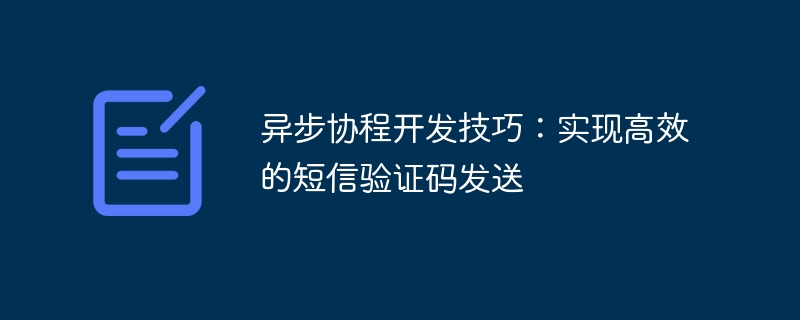

In the era of mobile Internet, SMS verification codes have become a necessary step for user registration, login, and password retrieval. However, sending SMS verification codes has always been a major difficulty in development, especially in high-concurrency scenarios, which often leads to a decrease in system performance. In order to solve this problem, this article introduces asynchronous coroutine development techniques and provides specific code examples to achieve efficient SMS verification code sending.
Understanding of asynchronous coroutines
Asynchronous coroutines are a kind of concurrent programming idea. In the traditional linear programming mode, the program runs in a certain order, that is, the program needs to wait The next step can only be performed after the previous step is completed. The idea of asynchronous coroutines is to divide the entire program into multiple independent task flows. These task flows can be executed concurrently. The progress of one task flow will not affect the execution progress of other task flows.
Advantages of asynchronous coroutines
Compared with traditional linear programming models, asynchronous coroutines have the following advantages:
Practical Case: Implementing Efficient SMS Verification Code Sending
In mobile Internet application development, SMS verification codes are often used to verify the user's mobile phone number. However, since sending SMS verification codes is a time-consuming operation, if the traditional linear programming model is used, it will easily lead to a decrease in system performance. Therefore, we can use the idea of asynchronous coroutines to decompose the sending process of SMS verification codes into multiple task flows to improve the processing capacity and throughput of the system.
To use Python language to implement an efficient SMS verification code sending service, you first need to install the aiohttp library. By using the aiohttp library, we can easily create asynchronous coroutines and implement concurrent sending of SMS verification codes.
Code example:
import asyncio
import aiohttp
async def send_message(phone_number: str, code: str) -> str:
api_key = "" # 填写短信API的Key
url = "" # 填写短信发送接口URL
data = {
"apikey": api_key,
"mobile": phone_number,
"text": f"【应用名称】您的验证码是{code}。如非本人操作,请勿泄露。"
}
async with aiohttp.ClientSession() as session:
async with session.post(url, data=data) as resp:
result = await resp.json()
return result["code"]
async def send_verification_code(phone_number: str) -> str:
code = generate_verification_code() # 生成短信验证码
await asyncio.sleep(5) # 模拟短信发送需要5秒钟
result = await send_message(phone_number, code) # 发送短信验证码
return result
async def main():
tasks = [send_verification_code("13000000000") for _ in range(10)] # 并发发送10条短信验证码
results = await asyncio.gather(*tasks)
print(results)
if __name__ == "__main__":
asyncio.run(main())The above code implements an asynchronous coroutine SMS verification code sending process. The specific implementation steps are as follows:
Through the above code implementation, we can find that even if 10 SMS verification codes are sent at the same time, the execution speed of the program will not be affected, and the system resources can be fully utilized to achieve efficient SMS verification. Code is sent.
Conclusion
This article introduces the development skills of asynchronous coroutines and provides specific code examples to achieve efficient SMS verification code sending. The idea of asynchronous coroutines can effectively improve the processing power and throughput of the system, especially in high-concurrency scenarios, it can show its advantages. Therefore, in mobile Internet application development, we can use the idea of asynchronous coroutines to achieve efficient business processing.
The above is the detailed content of Asynchronous coroutine development skills: realizing efficient SMS verification code sending. For more information, please follow other related articles on the PHP Chinese website!




